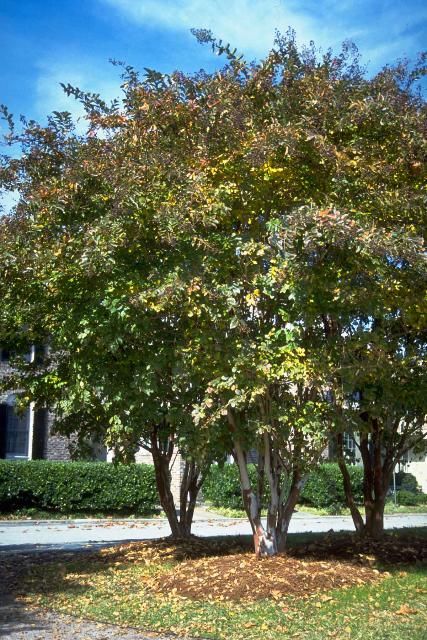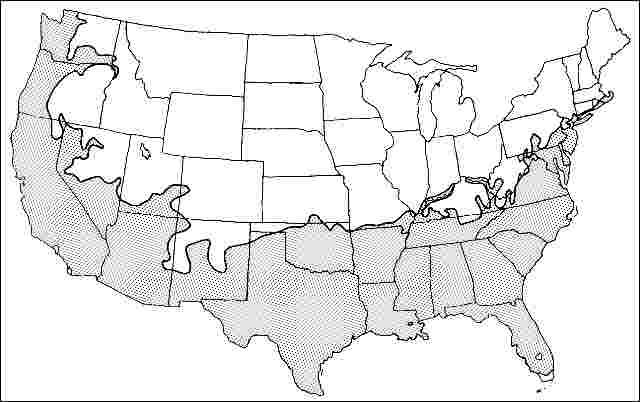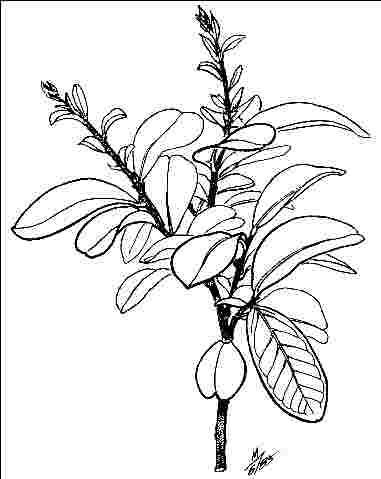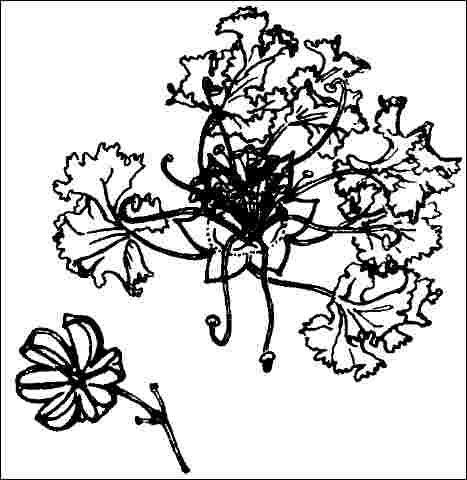Introduction
Japanese Crape-Myrtle is very similar to the more common Crape-Myrtle ( Lagerstroemia indica ) except it has smaller, white blossoms and larger leaves which show no appreciable fall color change. It is also larger in size than the common Crape-Myrtle. Japanese Crape-Myrtle is a slow-growing, deciduous tree which reaches 35 to 50 feet in height and has leathery, four-inch-long leaves. The flaking, peeling, red and brown bark (on trees trained as single or multi-trunked) is especially attractive in the winter garden, when the leaves have fallen. With lower branches removed, as is often the case with Crape-Myrtle, bark is also very showy during the entire year. The upright, vase-shaped crown makes Japanese Crape-Myrtle well-suited for street tree planting.

Credit: Ed Gilman
General Information
Scientific name: Lagerstroemia fauriei
Pronunciation: lay-ger-STREE-mee-uh FAR-ee-eye
Common name(s): Japanese Crapemyrtle
Family: Lythraceae
USDA hardiness zones: 6B through 10A (Fig. 2)
Origin: not native to North America
Invasive potential: little invasive potential
Uses: shade; street without sidewalk; specimen; parking lot island < 100 sq ft; parking lot island 100-200 sq ft; parking lot island > 200 sq ft; tree lawn 3-4 feet wide; tree lawn 4-6 feet wide; tree lawn > 6 ft wide; highway median; container or planter
Availability: somewhat available, may have to go out of the region to find the tree

Description
Height: 35 to 50 feet
Spread: 25 to 35 feet
Crown uniformity: symmetrical
Crown shape: vase
Crown density: dense
Growth rate: fast
Texture: medium
Foliage
Leaf arrangement: opposite/subopposite (Fig. 3)
Leaf type: simple
Leaf margin: entire
Leaf shape: elliptic (oval), obovate, oblong
Leaf venation: pinnate
Leaf type and persistence: deciduous
Leaf blade length: 2 to 4 inches
Leaf color: green
Fall color: no color change
Fall characteristic: not showy

Flower
Flower color: white/cream/gray
Flower characteristics: very showy

Fruit
Fruit shape: oval, round
Fruit length: less than .5 inch
Fruit covering: dry or hard
Fruit color: brown
Fruit characteristics: does not attract wildlife; showy; fruit/leaves not a litter problem
Trunk and Branches
Trunk/bark/branches: branches don't droop; very showy; typically multi-trunked; thorns
Pruning requirement: little required
Breakage: resistant
Current year twig color: green, brown
Current year twig thickness: thin
Wood specific gravity: unknown
Culture
Light requirement: full sun
Soil tolerances: clay; sand; loam; slightly alkaline; acidic; well-drained
Drought tolerance: high
Aerosol salt tolerance: moderate
Other
Roots: not a problem
Winter interest: yes
Outstanding tree: yes
Ozone sensitivity: unknown
Verticillium wilt susceptibility: unknown
Pest resistance: free of serious pests and diseases
Use and Management
Pruning should be done in late winter or early in the spring before growth begins because it is easier to see which branches require pruning. New growth can be pinched during the growing season, when the tree is very small, to increase branchiness and flower number but this is not needed to develop good form. The tree flowers very nicely without pruning. Lower branches are often thinned to show off the trunk form and color. You can remove the spent flower heads to encourage a second flush of flowers and to prevent formation of the brown fruits.
Japanese Crape-Myrtle would make a wonderful street tree for residential or commercial landscapes. Planted on 20-foot-centers, it would form a canopy over the sidewalk but the crown does not spread enough to canopy the street. Choose single-trunked trees for street planting, or well-formed, multi-trunked specimens with no embedded bark. The outstanding bark character makes it one of the best specimen trees for the South. This is likely to become a very popular tree.
Japanese Crape-Myrtle grows best in full sun with rich, moist soil but will tolerate less hospitable positions in the landscape just as well, once it becomes established. It will probably grow well in limited soil spaces in urban areas such as along boulevards and in parking lots.
Propagation is by cuttings or seed.
The cultivar `Fantasy' will become more available, 50 feet tall, white flowers, extremely showy flower display even on old trees, three-foot diameter trunk 35 years after planting, resistant to powdery mildew.
Pests
No pests are of major concern. Aphids probably infest the new growth to a certain extent causing a harmless but unsightly sooty mold to grow on the foliage.
Diseases
Although powdery mildew can severely affect most other Crape-Myrtles, Japanese Crape-Myrtle is very resistant.